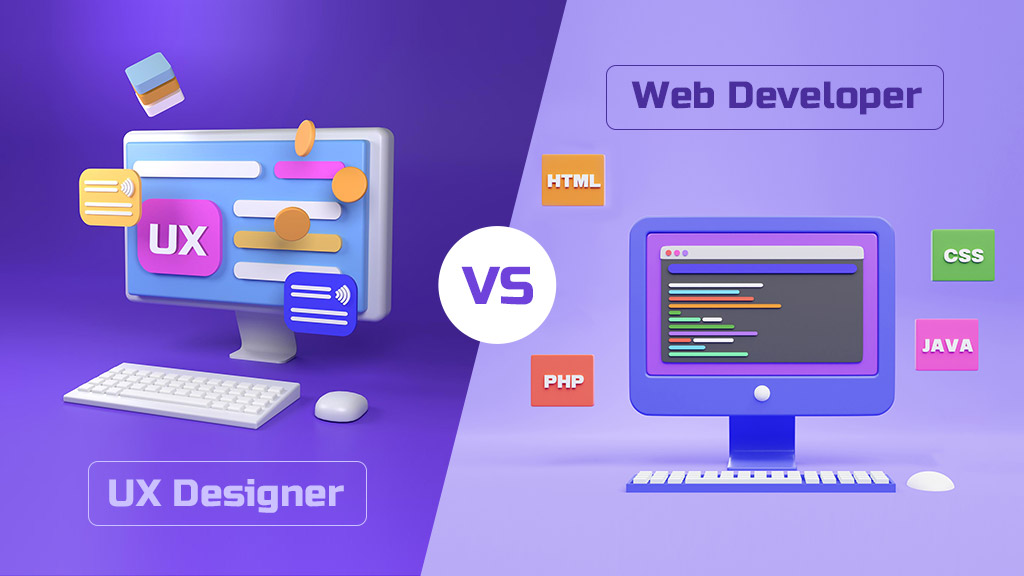
UX Designer Vs Web Developer: Knowing The Perfect Match For You!
In the dynamic world of tech, two pivotal roles, UX designers and web developers, stand at the forefront of digital innovation. While their contributions are integral to crafting exceptional online experiences, does the UX Designer vs. Web Developer role differ?
Yes, the roles of UX designers and web developers differ significantly. UX designers focus on user experience, research, and design, ensuring intuitive interfaces. Web developers, in contrast, concentrate on coding, technical implementation, and functionality. Each role uniquely contributes to creating successful digital products, with distinct skill sets and responsibilities.
This blog post aims to unravel the intricate differences and similarities between UX designers and web developers.
What Is UX Design & A UX Designer?

User Experience (UX) design focuses on enhancing a product or system’s overall satisfaction and usability by improving its accessibility, usability, and pleasure during interaction. A UX designer is a professional responsible for crafting this positive user experience. They employ a multidisciplinary approach, incorporating elements of psychology, design, and technology to create interfaces that resonate with users.
UX designers conduct extensive research to understand user needs, preferences, and behaviors, create wireframe prototypes, and work on usability testing to refine the design. They collaborate with cross-functional teams to integrate user feedback and iterate on designs. The ultimate goal is to ensure that the end product meets functional requirements and provides a seamless and enjoyable experience for the user.
Different Roles For UX Designers

1. UX Designer:
- Encompasses end-to-end design responsibilities, often prevalent in startup environments.
2. Specializations in Large Firms:
- Information Architecture: Organizing and structuring content for optimal user navigation.
- User Experience Research: Conducting in-depth studies to understand user behaviors and preferences.
- Usability Analysis: Assessing the effectiveness and efficiency of a product’s user interface.
- User Experience Authoring: Crafting engaging and user-friendly content.
3. Evolving Roles:
- User Experience Engineering: Focusing on the technical aspects of implementing design solutions.
- Interaction Design: Shaping the way users engage with a product.
4. Career Progression:
- Subject Matter Expert (SME): Achieved through expertise development.
- Management Roles: Progressing into project management, product management, or directorial positions within UX.
What Does A UX Designer Do?
User Research:
A UX designer’s journey begins with an in-depth exploration of the target audience. Through surveys, interviews, and analytics, they decipher user behaviors, needs, and pain points, shaping the foundation for design decisions.
Information Architecture:
The structuring of content takes center stage as UX designers meticulously organize information. Sitemaps and wireframes are crafted, providing a blueprint that ensures intuitive navigation and logical user flow.
Prototyping:
UX designers create interactive prototypes to visualize and refine the product’s functionality and design. This iterative process incorporates user feedback, fostering continual improvement.
Usability Testing:
The effectiveness and efficiency of a product are assessed through usability tests. Direct user feedback guides enhancements, ensuring the final product aligns seamlessly with user expectations.
Interaction Design:
Defining the user-product interaction is a pivotal aspect. UX designers carefully craft interfaces, shaping buttons, forms, and interactive elements to guarantee a smooth and intuitive user journey.
Visual Design:
Beyond functionality, aesthetics play a vital role. UX designers delve into visual elements, curating interfaces that align with brand identity and contribute to a pleasing user experience.
Collaboration:
In a collaborative dance, UX designers engage with cross-functional teams. Close coordination with developers, product managers, and marketers ensures the design aligns with overarching business goals.
Accessibility:
Inclusivity is paramount, with UX designers prioritizing accessibility for users of diverse abilities. Through thoughtful design solutions, they strive to make the product universally usable.
Keeping Up with Trends:
Remaining at the forefront of industry dynamics, UX designers stay abreast of emerging trends and technologies. This ongoing awareness informs their design decisions, ensuring relevance in a rapidly evolving landscape.
What Is Web Development And A Web Developer?

Web development is the process of creating and maintaining websites or web applications. It involves various tasks, including web design, content creation, coding, scripting, and server configuration. A web developer is a professional responsible for designing, building, and maintaining these websites or applications.
They work with various programming languages, frameworks, and tools to bring a website’s visual and functional elements to life. Web developers can be categorized as frontend developers, who focus on the user interface and client-side interactions, and backend developers, who manage server-side operations and database functionality. Together, they collaborate to ensure seamless and compelling web experiences for users.
Types Of Web Developing Jobs

Backend Developer:
Backend developers specialize in server-side programming. They manage the server, database, and application logic, ensuring the website’s or web application’s smooth functioning. Proficiency in Python, Ruby, Java, or PHP is standard.
JavaScript Engineer:
JavaScript engineers focus on client-side development, using JavaScript to create interactive and dynamic user interfaces. They work closely with frontend and backend developers to ensure seamless integration of features.
Full Stack Developer:
Full Stack Developers possess a comprehensive skill set covering frontend and backend development. They are proficient in various languages and frameworks, allowing them to handle all aspects of web development, from user interface design to server management.
Front End Developer:
Frontend developers craft the visual elements of a website or web application that users interact with. They use languages such as HTML, CSS, and JavaScript to create responsive and visually appealing user interfaces, ensuring an optimal user experience.
What Does A Web Developer Do?
A web developer is responsible for various critical tasks in creating and maintaining websites. Their primary focus is on writing the code that forms the foundation of a website, using multiple programming methods and tools to achieve reliable outcomes. Here are eight significant responsibilities that encapsulate the role of a web developer:
1. Building the Website from the Ground Up:
Web developers construct websites from scratch, utilizing code rather than relying on no-code builders. They follow industry norms and principles, ensuring a reusable, understandable, and easily adaptable code environment.
2. Testing the Website:
Frequent site testing is imperative to catch issues early. Before launching the application, developers check the code for errors, preventing future complications. Regular testing and validation of the code contribute to maintaining the functionality and performance of the website.
3. Debugging Website Code:
Identifying and rectifying errors in a website’s code is crucial for its usability. Developers optimize the code to enhance speed after resolving bugs. Effective debugging improves customer satisfaction and lays the groundwork for future expansion.
4. Website Maintenance and Changes:
Web developers ensure the website’s continued functionality and assist with necessary changes. They are responsible for disseminating updates, providing security, and promptly addressing discrepancies to satisfy clients.
5. Collaboration with Designers:
Web developers work closely with designers to interpret and bring their visual intentions to life. Collaboration is essential to create a cohesive visual aesthetic that adapts to different screen sizes and ensures all crucial features are incorporated into the final product.
6. Database Administration:
Managing databases is crucial for web developers as nearly all software processes substantial data volumes. They synchronize data between internal memory and distant databases for offline application usage, emphasizing the importance of understanding databases in mobile development.
7. Maintaining a Flexible Layout:
Web developers ensure responsive design, allowing websites to seamlessly adapt to various device screens. Fluid grids, layouts, and intelligent coding are employed to scale web pages correctly, enhancing the user experience across different devices.
8. Additional Responsibilities:
Beyond fundamental tasks, web developers may create readable design documentation, secure web applications, work with various programming languages, use images effectively, keep track of software documentation, and plan for site failure using backup systems.
UX Designer Vs Web Developer: What Are The Differences?

1. Focus and Expertise:
- UX Designer: UX designers primarily create a positive and seamless user experience. Their focus extends beyond the visual design of a website or application, encompassing user research, information architecture, and interaction design. UX designers delve into understanding user behaviors, preferences, and pain points to craft aesthetically pleasing, intuitive, and functional interfaces.
- Web Developer: Web developers, on the other hand, specialize in building the technical infrastructure of a website or application. Their expertise lies in coding, server management, and ensuring the website’s functionality. While they may contribute to the user interface, their primary concern is implementing features and optimizing code for performance.
2. Responsibilities in the Design Process:
- UX Designer: UX designers are integral to the early stages of the design process. They conduct user research, create wireframes and prototypes, and work closely with stakeholders to define the overall user experience. Their role is more strategic and user-focused, aiming to align the design with user needs and business goals.
- Web Developer: Web developers come into play during the implementation phase. They take the designs provided by UX designers and turn them into functional websites or applications. Their responsibilities include coding, debugging, and ensuring the technical aspects of the site are robust. Web developers work closely with UX designers but are more concerned with the execution of the design rather than its conceptualization.
3. Skill Set:
- UX Designer: UX designers require a skill set that includes user research, information architecture, prototyping, and interaction design. They need a deep understanding of human psychology and behavior to create designs that resonate with users. Proficiency in design tools such as Sketch, Figma, or Adobe XD is essential.
- Web Developer: Web developers need strong coding skills and a deep understanding of programming languages like HTML, CSS, and JavaScript. They must be adept at working with frameworks and libraries and have a solid grasp of server-side technologies. Web developers often use Visual Studio Code, Sublime Text, or Atom for coding and debugging.
4. Concerns During the Design Process:
- UX Designer: UX designers are primarily concerned with the user journey, information flow, and product usability. They focus on creating wireframes and prototypes to test and refine the user interface. Their goal is to ensure that the end product is intuitive and aligns with the needs and expectations of the users.
- Web Developer: Web developers are more concerned with the technical aspects of the design, such as coding the front end and backend of the website. They work to ensure that the website or application functions smoothly, handling issues like server-side processing, database management, and optimizing code for performance.
5. User-Centric vs. Code-Centric:
- UX Designer: UX designers are inherently user-centric. They constantly advocate for the user’s perspective, conducting usability testing and gathering feedback to refine the design. Their decisions are driven by the goal of improving the overall user experience.
- Web Developer: Web developers are code-centric, focusing on the technical implementation of the design. Their decisions revolve around writing efficient and error-free code, optimizing performance, and ensuring the website or application functions as intended.
6. Iterative vs. Implementation:
- UX Designer: UX design is an iterative process. Designers create prototypes, gather user feedback, and iterate on the design based on that feedback. The emphasis is on refining the design through multiple cycles to achieve the best possible user experience.
- Web Developer: Web development is more about implementation. Once the design is finalized, web developers take on the task of turning those designs into a functional product. They focus on efficiently translating the design into code and ensuring the website or application works correctly.
7. Deliverables:
- UX Designer: UX designers typically deliver wireframes, prototypes, user personas, and user journey maps as part of their deliverables. These artifacts help communicate the design concepts and the intended user experience to stakeholders and development teams.
- Web Developer: Web developers deliver the actual coded product. Their output includes the website or application itself, databases, server configurations, and other technical components required for the product’s functionality.
What Are The Similar Roles Of A UX Designer And A Web Developer?

1. Coding Knowledge:
Both UX designers and web developers benefit from having a foundational understanding of coding. While UX designers may not write production-level code, familiarity with HTML, CSS, and JavaScript allows them to communicate effectively with web developers and understand the technical constraints and possibilities.
2. Prototyping Tools:
Both roles use prototyping tools as part of their workflow. UX designers leverage tools like Sketch, Figma, or Adobe XD to create interactive prototypes demonstrating user flow and design concepts. Web developers may also use prototyping tools to visualize and test certain aspects of the website or application.
3. Responsive Design:
Both UX designers and web developers are involved in ensuring responsive design. UX designers create designs adaptable to various screen sizes and devices. At the same time, web developers implement responsive coding practices to achieve fluid layouts and optimal user experiences across different devices.
4. Version Control:
Version control systems, such as Git, are utilized by both UX designers and web developers. While web developers use version control to manage code repositories and track changes, UX designers may collaborate on design files, track iterations, and maintain a version history of design assets.
5. Cross-Browser Compatibility:
Both roles are concerned with cross-browser compatibility. UX designers must consider how their design will translate across different browsers, ensuring a consistent user experience. Web developers are responsible for coding in a way that accommodates various browsers and ensures that the website functions correctly across different platforms.
How To Become A UX Designer?

1. Educational Foundation:
Start by obtaining a foundational education in a relevant field such as graphic design, human-computer interaction, psychology, or a related discipline. Many UX designers hold degrees at the bachelor’s or master’s level, but a formal education is not always mandatory.
2. Gain Relevant Skills:
Develop essential UX design skills. Familiarize yourself with design tools like Sketch, Figma, or Adobe XD. Learn about user research, information architecture, wireframing, prototyping, and usability testing. Acquire proficiency in HTML, CSS, and basic coding for a more comprehensive skill set.
3. Build a Portfolio:
Create a strong portfolio showcasing your UX design projects. Include case studies that highlight your design process, problem-solving skills, and the impact of your work on user experiences. A well-documented portfolio is crucial for demonstrating your abilities to potential employers.
4. Gain Practical Experience:
Apply your skills in real-world scenarios. Seek internships, freelance opportunities, or personal projects to gain hands-on experience. Practical application allows you to encounter real challenges, refine your skills, and build a track record of successful projects.
5. Network and Connect:
Engage with the UX design community through networking events, conferences, and online platforms. Connect with professionals in the field, participate in discussions, and seek mentorship. Networking can open doors to job opportunities, industry insights, and valuable connections.
6. Stay Updated on Industry Trends:
Stay informed about the latest UX design trends, tools, and technologies. Follow influential designers, read industry blogs, and participate in online forums. Continuous learning is essential in a rapidly evolving field.
7. Apply for Entry-Level Positions:
Start applying for entry-level UX design positions or internships. Tailor your resume and cover letter to highlight your skills and experiences. Be prepared to showcase your portfolio and articulate your design decisions in interviews. Consider gaining experience in different industries to diversify your portfolio.
How To Become A Web Developer?

1. Acquire the Necessary Education:
Start with a solid educational foundation. While a formal degree is beneficial, it’s not always mandatory. Many web developers are self-taught or attend coding bootcamps. Focus on learning core programming languages like HTML, CSS, and JavaScript.
2. Master Core Technologies:
Gain proficiency in essential web development technologies. Understand how to build the structure (HTML) and style (CSS) and add interactivity (JavaScript) to websites. Familiarize yourself with frameworks and libraries like React, Angular, or Vue.js.
3. Build a Strong Portfolio:
Create a portfolio showcasing your projects. Include a variety of projects that highlight different skills and technologies. This demonstrates your capabilities to potential employers and serves as a personal showcase of your evolving skills.
4. Practice Regularly:
Consistent practice is key to becoming proficient. Work on real-world projects, contribute to open-source projects or participate in coding challenges. The more hands-on experience you have, you’ll become more confident and capable.
5. Stay Updated on Industry Trends:
Web development is a dynamic field with ever-evolving technologies. Stay informed about the latest trends, tools, and frameworks. Follow blogs, attend conferences, and engage with the web development community to stay abreast of industry changes.
6. Networking and Collaboration:
Connect with other web developers through local meetups, online forums, and social media. Networking provides opportunities for collaboration, learning, and potential job leads. Collaborating on projects with other developers can enhance your skills and broaden your perspective.
7. Apply for Jobs and Internships:
Start applying for entry-level web development positions or internships to gain practical experience in a professional setting. Emphasize your portfolio and hands-on projects during job applications and interviews. Be open to junior positions that allow you to continue learning and growing in the field.
UX Designer Vs Web Developer: Job Market Overview & Salary Range

The job market for both UX designers and web developers is robust, with a promising outlook for the coming years. The Bureau of Labor Statistics anticipates a 23% increase in demand for both roles between 2021 and 2031, surpassing the average national job growth projection of 5%. The job outlook for web developers is exceptionally bright, with a projected 94% employment rate by 2023.
In terms of salary, Glassdoor reports that the average annual salary for a web developer in the United States is $81,957. This figure includes a base income of $77,367 and an average of $4,589 in bonuses annually. Alternative forms of compensation, such as commissions and profit-sharing, may also contribute to the overall remuneration.
For UX designers, the average compensation stands at $83,421, according to Glassdoor. However, the salary range for UX designers is quite diverse, with professionals earning anywhere from $55,000 to $125,000 per year. This variability is influenced by experience, location, and the specific industry in which the designer works.
In summary, UX designers and web developers can expect a favorable job market with increasing demand. While web developers earn an average salary of $81,957, UX designers command a slightly higher average of $83,421, with significant variability based on individual factors.
FAQs
What is the primary focus of a UX designer compared to a web developer?
A UX designer focuses on creating a positive user experience, emphasizing usability, user research, and interface design. In contrast, a web developer is more code-centric, concentrating on the technical implementation of the website or application, ensuring its functionality and performance.
How do the roles of UX designers and web developers differ during the design process?
UX designers play a strategic role in the early design phases, conducting user research, creating wireframes, and defining the overall user experience. Web developers, in contrast, come into play during the implementation phase, turning design concepts into functional products through coding and technical execution.
What are the key skills required for a UX designer compared to a web developer?
UX designers need skills in user research, information architecture, and prototyping tools. On the other hand, web developers require strong coding skills, proficiency in programming languages, and familiarity with frameworks and libraries.
How do UX designer vs web developer contribute to problem-solving in their respective domains?
UX designers address design-related challenges, focusing on user interactions and overall usability. Web developers contribute to technical problem-solving, optimizing code, resolving bugs, and ensuring the smooth functioning of the website or application.
Is there a significant difference in the career paths of UX designers and web developers?
While both roles share foundational skills, UX designers often progress towards roles like UX subject matter experts or move into management positions. Web developers may specialize in areas like frontend or backend development, and some may transition into roles like project managers or software architects. The career paths reflect the distinct focuses and expertise of each position.
Finally, UX Designer Vs Web Developer: Which Is Better Career?
The choice between a career as a UX designer or a web developer ultimately depends on individual interests, skills, and career preferences. Both roles offer rewarding opportunities and have a growing demand in the job market.
If you are passionate about creating seamless user experiences, conducting user research, and designing interfaces, a career as a UX designer might be a better fit. On the other hand, if you enjoy coding, building technical solutions, and ensuring the functionality of websites or applications, pursuing a career as a web developer could be more aligned with your interests.
Ultimately, the “better” career is subjective and depends on your strengths and interests. Some individuals find satisfaction in the creative and strategic aspects of UX design, while others thrive in web development’s technical and problem-solving challenges.

















































